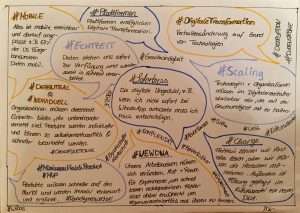#DigitalTransformation and #RealTime
One of these characteristics is digital transformation. We talk about digital transformation when our behavior changes permanently due to technology. One example: Whereas we used to raise the camera to our eye to aim at our subject, today we look at the display of our camera or cell phone to take a photo.
We then look at the picture immediately and decide whether we like it or not. If we like the picture, we add a short comment and upload it to platforms such as Facebook, Twitter or WhatsApp. Here, our family, friends, acquaintances and followers can comment on and like our picture in real time. These technologies, which were not available to us before the internet, smartphones etc., make it easier for us to stay in touch with others.

In order to be at the forefront of digitalization, organizations must develop solutions that bring additional quality of life. Companies can tell whether their product is penetrating the market and changing it sustainably by the change in customer behavior.
#Platforms and #Sofortness
Platforms such as Facebook, Twitter and WhatsApp create the basis for digital transformation. They make data streams visible, for example with hashtags such as #JeSuisCharlie or #PanamaPapers. Platforms offer us the opportunity to exchange information in real time - which leads us to expect an immediate response to a post. This digital impatience is also described as "immediacy". Let's take a WhatsApp message as an example: the sender can see whether the recipient of their message has already read it. If they have, the message is marked with a tick. If the sender does not receive a reply immediately after reading a message, many people find this impolite. The sender expects an apology from a recipient who writes back after a delay.
Platforms play a central role in digitalization. They serve as multipliers through which products, organizations and services can be reached. If products and organizations are accessible in this way, customers also expect an immediate response. If this is not possible, the immediacy can be appeased through transparency. For example, many delivery services offer a status overview of the order process after the online order has been placed. This allows the customer to track whether their order is being processed or delivered.
#Decentral and #MVP
Markets are changing rapidly, and at the same time product life cycles are becoming increasingly shorter. Today's customers expect organizations to respond to new requirements in the shortest possible time and implement them in their products and services. Accordingly, it is important to react quickly to requirements. However, this also means that organizations only need to implement those requirements that are important to customers immediately. The less important ones can be implemented later. This enables a focus on the core functionality and iterative adaptation of the product. Such a product is also known as a "minimum viable product", or MVP for short.
MVPs are brought to market quickly and then adapted and improved iteratively. A large organization is usually far too cumbersome for such an approach. Small, decentralized units can act much faster on the market. Companies therefore need to think about new forms of organization that enable decentralization. This allows them to bring products to market or take them off the market more quickly. Companies also need the courage to cannibalize their own products if necessary, i.e. to displace existing products from the market with newer products of their own.
#Mobile and #Scalable
A product optimized for the desktop is also no longer enough, as Zenith's "Media Consumption Forecast" shows. According to this report, 71% of Internet use worldwide is on mobile devices, and the trend is rising. This 71% shows that the majority of users expect a mobile solution - so mobile technology can be seen as the new standard.
Digital solutions must not only be accessible on the move, but also flexibly scalable as demand increases. In this context, "scalable" means not only the technological aspect, such as server capacity, but also the form of the organization. An organization with a decentralized structure must be able to quickly set up several teams for a product that is in demand.
#NewDNA and #Change
Organizations are required to bring their products to market quickly as MVPs. Technologies and organizational units must also be scalable so that they can react flexibly to increasing or decreasing demand. This requires a new attitude in the collaboration of the people who build these products and work in flexible organizational forms. Employees must be encouraged to experiment. Mistakes must be allowed so that we can learn from them together. Otherwise, we will continue to try to launch products with as many functions as possible instead of MVPs.
These are changes that have an impact on an organization's values and require a cultural change. This cultural change is often referred to as the "new DNA for organizations". Digitalization is leading to profound change at all levels of an organization.

Comments
Write a comment